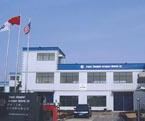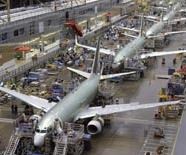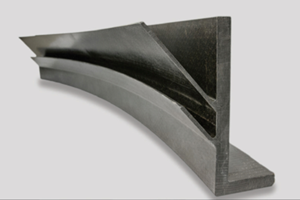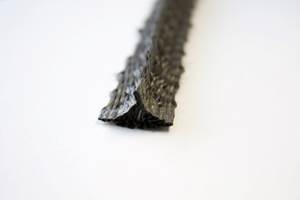Distributors and their role
These key players in the supply chain provide indispensable services not just in the commodity markets but in advanced material arenas as well.
Often looked on as middlemen that add costs to material purchases, distributors are, in fact, a vital link in the composites industry, bringing tangible benefits to both material suppliers -- those manufacturing the materials -- and end-users. Composites industry veteran Ben Rasmussen, president of market research firm BMR Assoc. (Plainfield, N.J.) says that distributors fill a void that most suppliers simply can't, because of the sheer numbers of customers and their geographic diversity. "Distributors are riding a wave of business growth and maturation that should continue for several years to come," he adds.
HPC decided to take a look at composite material wholesale distribution and how it works for the broader commodity product markets and the aerospace industry. (Watch for our article on distribution for nonaerospace markets in our sister publication Composites Technology, in its upcoming April issue.)
The functions of a distributor
In industries such as composites, where many of the materials are made continuously and/or in large batches, shipments also must be large, in the form of truckloads or railcars, to make economic sense. From a practical standpoint, it's not feasible for a single supplier to fulfill many thousands of small orders to customers around the world. Enter the distributor, who buys large material quantities from a supplier/manufacturer, then creates smaller material units and delivers those units to many customers, in a timely fashion. They are distinct from brokers, who neither take delivery or nor title to the material, and surplus buyers, who typically buy aged material or overage and resell it at a discount.
Unlike big users that can buy truckload quantities direct from a supplier, most composites manufacturers have neither the cash flow nor the storage space to make that approach viable. The distributor, however, has both storage space and the resources to purchase product in quantity, as well as the equipment and personnel necessary to sort and package it in small orders. They can, in effect, manage the small manufacturer's inventory for him. Good communication between the distributor and customer ensures an unbroken supply chain, and helps the distributor manage his own warehouse inventory, to ensure timely material turnover and no dead stock or stock outs. Successful distributors, therefore, are shipping experts, using either their own truck fleets or cost-effective common carriers.
An important benefit provided to end-users is financing and credit, critical to both small and large businesses, particularly during down cycles, says one distributor's spokesman. Another is assuming the responsibility for product quality. The distributor's relationship both with the material supplier and hundreds (or thousands) of customers gives him leverage to resolve quality issues -- the supplier doesn't want to risk losing his customer base. Third, the distributor is knowledgeable about all of his suppliers' products, and can offer technical advice and training to his customers, to help them make the right material choices. He also can provide market intelligence, alerting end-users to price trends or impending shortages. The suppliers benefit as well, using use that intelligence to forecast demand or develop new products based on the distributor's widespread customer base.
One-stop shopping in U.S.
For nonaerospace markets, which include commodity goods ranging from tub/shower units to sporting goods, distributors in North America tend to be large in size, represent many competing suppliers and are often owned by or are a division of a resin company. In contrast, Europe tends to have more exclusive, smaller distributors, each serving a smaller customer base.
Composites One (Arlington Heights, Ill.), formed in 1999, is North America's largest distributor, with more than 8,000 customers, and is owned, in part, by Cook Composites & Polymers (CCP, Kansas City, Mo.). Like its competitors, it sells many brands, based on a philosophy of providing "everything for everyone," including resins from other manufacturers. Its trained sales force helps customers make prudent material selections, and assists users with technical issues. One hot-button issue is converting from open to closed molding. To assist users further, distributors also arrange customer access to industry experts, says Composites One president and COO Leon Garoufalis. In addition to a business-to-business Web site where order status and history can be checked automatically, Composites One has cutting and kitting operation at its warehouse facility in Lakeland, Fla., designed to streamline customers' production. The company can supply carbon fiber, epoxy resin and other products for advanced, nonaerospace applications.
However, the material supply chain in the aerospace market tends not to conform to commodity distribution as described above. Because most aerospace composite programs are built around prequalified materials, often materials supplied by just one manufacturer, end-users usually buy direct from that manufacturer. Numbers of parts are typically set by contract, so material quantities are known well in advance and can be ordered with long lead times.
But, ongoing development of new composite-intensive aircraft models by The Boeing Co. (Chicago, Ill.) and Airbus Industrie (Toulouse, France) has led to significant work-sharing by manufacturers in parts of the world far removed from aerospace material suppliers. International sub-contracting of aircraft parts is now the norm rather than the exception. Because a part manufactured in Asia still has to be made with the same pre-qualified composite materials used in Seattle, St. Louis or Toulouse, providing materials to these fabricators is critical. One carbon fiber supplier notes that without an Asian production plant, he has to depend on distributors to get his material to the customer in Asia and the Pacific Rim.
A global supply chain
Argosy International (New York, N.Y. and Shanghai, China) specializes in distributing high-performance qualified and certified aerospace materials from the U.S. and Europe to the Asian Pacific markets. Argosy represents Cytec Engineered Materials Inc. (Tempe, Ariz.), Akzo Nobel Aerospace Coatings (Chicago, Ill.), Airtech International (Huntington Beach, Calif.) and other major aerospace suppliers. "We're focused on increasing the productivity of our customers, and we do that by partnering with our suppliers and supplementing added-value services," says Argosy's Paul Marks.
To achieve cost reductions in a region where shipping can account for 30 to 50 percent of the price of material, Argosy bundles multiple offshore shipments whenever possible to reduce cost. Prepregs are shipped frozen in refrigerated sea containers from Los Angeles directly to the end-user or to multiple warehouses located in China, South Korea, Taiwan, Malaysia and Indonesia, all equipped with freezer capacity. The process is made more complex by the need to differentiate duty-free materials, used to make aircraft parts that will be exported, from materials that will become parts sold in the country, which are subject to value-added tax (VAT) and other charges. The far-flung enterprise is managed by "really good IT specialists," says Marks. Backup computer systems in several cities, including New York and Shanghai, ensure that a crash in one location doesn't bring the company's operations to a halt.
Argosy's services also include repackaging and kitting of prepregs and cores, to simplify fabrication. As a side business, and to support its distribution, Argosy has already established five Chinese plants, which produce woven goods, coatings, honeycomb core and specialty fabrics under license to several of its major suppliers, for both local delivery and export back to the suppliers. "Our converting and manufacturing businesses support our local distribution services," states Marks. "We have a full range of product types, but not a broad offering of suppliers, because of our exclusive partner agreements with a few firms."
Marks foresees Asian material suppliers eventually becoming qualified to manufacture materials for aerospace programs. "As more aerospace manu-facturing moves to the Asian Pacific region, the material supplies need to move as well," he says. As an example, there is ongoing development of carbon fiber manufacturing capacity in China, which could be online sometime in 2006.
On a smaller scale, Lavender CE Pty. Ltd. (Acacia Ridge, Queensland, Australia) supplies the Pacific Rim and Australia with high-performance advanced materials from a single warehouse, says managing director Rudi Steinbusch. Its product offerings include prepregs from Advanced Composites Group Ltd. (Heanor, Derbyshire, U.K.) and epoxy resin from French supplier Sicomin (Chateauneuf-les-Martigues, France). Principal customers are marine and motorsports fabricators. "Lead times are a big issue, particularly with materials shipped via sea freight," says Steinbusch. When supplying smaller orders of prepreg, air freight is typically used due to the large distances involved and to maximize shelf life.
Lavender adds value for customers by providing in-house engineering capability to do structural analysis, including finite element analysis (FEA) and computer-aided design (CAD), for composites as well as other materials.
De-Comp Composites Inc. (Cleveland, Okla.) exemplifies the distributors who have successfully carved a niche by supplying both aerospace and commodity markets, says general manager Rex Nutter. "Aerospace customers make up about 25 percent of our business, with the remainder spread across sporting goods, automotive, marine, electronics and infrastructure." Affiliated with resin supplier Resin Services Inc. (Sterling Heights, Mich.), the company supplies a complete line of both primary materials and consumables like sealant tape, breather, peel ply and vacuum bagging components as well as "a lot of tooling material."
Most shipping is done via common carriers and UPS. The company is continuously evaluating the need for additional warehouses. Currently, Nutter says the company is looking at the west coast for its next facility, to provide better service and minimize freight costs to Asia.
"The best distributors blur the lines between the supplier and the distributor, giving the customer seamless service," says Marks. Given the diversity of the composites manufacturing industry and the growing global economy, distributors will continue to play a key role in customer success -- far into the future.
Related Content
CAMX 2022 exhibit preview: Bally Ribbon Mills
Bally Ribbon Mills’ highlights its capabilities in design and manufacture of woven structural shapes for hybrid composite structures used in aerospace applications.
Read MoreComposite resins price change report
CW’s running summary of resin price change announcements from major material suppliers that serve the composites manufacturing industry.
Read MoreBiteam introduces 3D Noodle International AB spin-off for 3D fabric noodles
Biteam 3D’s third spin-off implements its proprietary 3D weaving technology to produce a variety of carbon, ceramic and other fiber 3D fabric noodle preforms.
Read More3D weaving capabilities achieve complex shapes, reduce weight and cost
JEC World 2024: Bally Ribbon Mills is displaying film-infused 3D woven joints, woven thermal protection systems (TPS) and woven composite 3D structures.
Read MoreRead Next
CW’s 2024 Top Shops survey offers new approach to benchmarking
Respondents that complete the survey by April 30, 2024, have the chance to be recognized as an honoree.
Read MoreComposites end markets: Energy (2024)
Composites are used widely in oil/gas, wind and other renewable energy applications. Despite market challenges, growth potential and innovation for composites continue.
Read MoreFrom the CW Archives: The tale of the thermoplastic cryotank
In 2006, guest columnist Bob Hartunian related the story of his efforts two decades prior, while at McDonnell Douglas, to develop a thermoplastic composite crytank for hydrogen storage. He learned a lot of lessons.
Read More
































